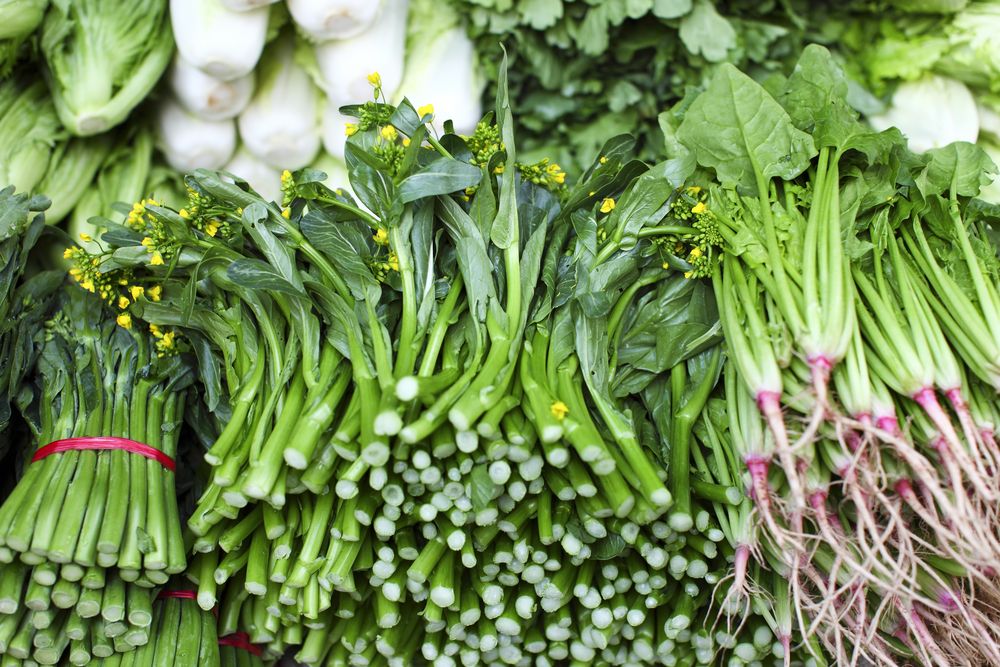Have you ever said something tasted green? What did you mean by that? Did you mean fresh and aromatic or earthy and alkaline? Do all greens taste the same? Can one substitute one green for another? Do all greens pair equally well with the same foods?
The long and short of it is that “green” is hardly a usable adjective when it comes to talking about flavor. I’m guilty of this inaccuracy and so, in the interest of better communication, and hopefully, better cooking, I’ve compiled a list of the flavor profiles and textures of many of the greens we regularly cook with. Take a look and you’ll see, rather than one general “green,” there’s a panoply, nay a veritable symphony of characteristics, primary and secondary flavors, and notes that make them all wonderfully unique.
Asparagus
Grassy, mild with undercurrents of lemon citrus and very slight earth or alkaline quality.
Texture: Stringy/Fibrous
Arugula
Sharp, bitter, highly aromatic flavor that freshens the olfactory senses. Notes of pepper can range from mild to a very strong medicinal flavor.
Texture: Tender
Beet Greens
Sweet, mild, earthy beet greens have notes of spinach or chard, but are milder than either of those greens. They pair well with similarly lighter fare like chicken, light-colored mushrooms, young beans and citrus flavors of any kind.
Bok Choy
Has a mild, sweet flavor, akin to Savoy cabbage with a bit of leek. In the cabbage family, bok choy makes a good alternative for a lighter cabbage or cruciferous flavor.
Texture: Sturdy
Broccoli
Grassy with slightly alkaline, floral notes; relatively neutral.
Texture: Firm
Broccoli Raab aka Broccoli Rabe
Slender, long, leafy stalks topped with small clusters of tiny buds. Stalks, leaves and buds can be eaten.
Flavor: Sharp/Bitter
Brussels Sprouts
Earthy, acidic with an intensified cabbage flavor. Whereas cabbage is generally neutral, Brussels sprouts intensify the earthy quality of regular cabbage and pair well with slightly sweet, acidic flavors that will stand up to their more assertive nature. Fats work wonders too which is why balsamic and bacon are such common accompaniments.
Texture: Crunchy
Butter Lettuce
Sweet, neutral, buttery. Pairs well with acids like lemon and vinegar. A great conveyor for peppery or pungent flavors.
Texture: Crunchy
Cabbage
Neutral, earthy, sweet cabbage naturally pairs well with anything salty and savory. The high liquid content, however, makes it susceptible to overcooking and sogginess.
Texture: Tender (when cooked)
Chinese Broccoli
Grassy with slightly pungent, bitter notes akin to turnip or mustard greens. Substitute Chinese broccoli in lieu of regular broccoli for more presence in curries or alongside beef or foods with umami taste.
Texture: Firm
Chard
Bitter, pungent, earthy and salty, chard has a flavor profile similar to collards but with a significant salty taste that makes them a great choice for salt-lovers who are watching their salt intake. Also, their flavor does not linger as much as collards, and their leaves are thin, tender and quick cooking. Chard works well with slightly astringent, acidic flavors like tomato and holds its own alongside sausage, legumes and anything in a stew.
Texture: Tender
Collard Greens
Assertive and acidic with bitter overtones that linger on the palate. Not all people will taste the bitterness which is dependent on genetic predisposition. Because of their strong flavor, collards pair well with mellowing agents like fats such as bacon fat, oils and creams.
Texture: Hearty
Dandelion Greens
Bitter x 2, dandelion greens are anything but subtle. Notes of pepper and lemon are present but generally the bitterness is what makes these greens either so appealing or off-putting depending on an individual’s likes and dislikes. Garlic, lemon, vinegar and other strong flavors hold their own against dandelion greens. For a mellowing effect, pair with sweet umami flavors like black bean paste.
Texture: Tender
Iceberg Lettuce
Neutral, sweet, notes of cucumber.
Texture: Crunchy
Kale
Kale has a distinctive sharp, complex, bitter and very earthy flavor that makes it a vegetable that’s as equally loved as it is despised. Nevertheless, kale is quite versatile and pairs well with both dark and light meats. For complementing flavors, opt for sharp cheeses like Parmigiano-Reggiano. For contrasting flavors, go with something that has a pinpoint, discernable sharpness like cranberry or mandarin orange. Heavy creams will mellow kale’s flavor and added funk, and umami will help round out the flavor.
Kohlrabi
Earthy, slightly bitter with notes of radish. Offset bitter quality with sweet flavors like black olive or complement with funk from cheese and stronger flavors like garlic, red chili and mustard.
Texture: Sturdy
Leeks
Sweet, citrusy, alkaline and slightly pungent, these mildly flavored “onions” don’t want to get drowned out by lots of other ingredients. Mild acidity, mild fat set the stage for leeks to really sing.
Texture: Crunchy
Romaine Lettuce
Sweet with very slight earthy flavor.
Texture: Hearty/Crunchy
Spinach
Earthy with acidic tones, making it a good choice for pairing salty, fatty and nutty tastes. The earthy quality often does not pair well with fish.
Texture: Hearty





